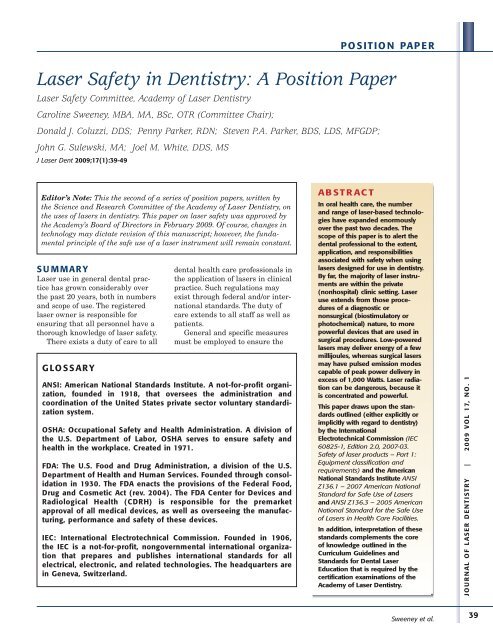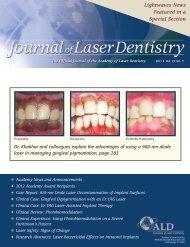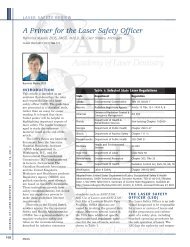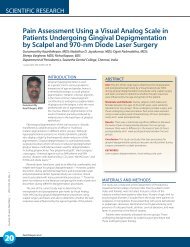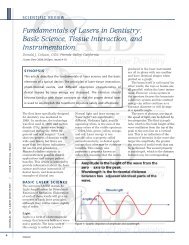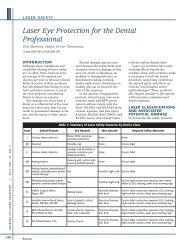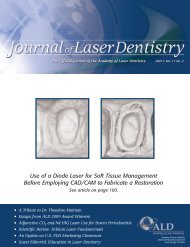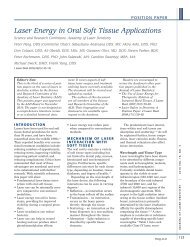Dental Lasers - Academy of Laser Dentistry
Dental Lasers - Academy of Laser Dentistry
Dental Lasers - Academy of Laser Dentistry
Create successful ePaper yourself
Turn your PDF publications into a flip-book with our unique Google optimized e-Paper software.
POSITION PAPER<br />
<strong>Laser</strong> Safety in <strong>Dentistry</strong>: A Position Paper<br />
<strong>Laser</strong> Safety Committee, <strong>Academy</strong> <strong>of</strong> <strong>Laser</strong> <strong>Dentistry</strong><br />
Caroline Sweeney, MBA, MA, BSc, OTR (Committee Chair);<br />
Donald J. Coluzzi, DDS; Penny Parker, RDN; Steven P.A. Parker, BDS, LDS, MFGDP;<br />
John G. Sulewski, MA; Joel M. White, DDS, MS<br />
J <strong>Laser</strong> Dent 2009;17(1):39-49<br />
Editor’s Note: This the second <strong>of</strong> a series <strong>of</strong> position papers, written by<br />
the Science and Research Committee <strong>of</strong> the <strong>Academy</strong> <strong>of</strong> <strong>Laser</strong> <strong>Dentistry</strong>, on<br />
the uses <strong>of</strong> lasers in dentistry. This paper on laser safety was approved by<br />
the <strong>Academy</strong>’s Board <strong>of</strong> Directors in February 2009. Of course, changes in<br />
technology may dictate revision <strong>of</strong> this manuscript; however, the fundamental<br />
principle <strong>of</strong> the safe use <strong>of</strong> a laser instrument will remain constant.<br />
SUMMARY<br />
<strong>Laser</strong> use in general dental practice<br />
has grown considerably over<br />
the past 20 years, both in numbers<br />
and scope <strong>of</strong> use. The registered<br />
laser owner is responsible for<br />
ensuring that all personnel have a<br />
thorough knowledge <strong>of</strong> laser safety.<br />
There exists a duty <strong>of</strong> care to all<br />
GLOSSARY<br />
dental health care pr<strong>of</strong>essionals in<br />
the application <strong>of</strong> lasers in clinical<br />
practice. Such regulations may<br />
exist through federal and/or international<br />
standards. The duty <strong>of</strong><br />
care extends to all staff as well as<br />
patients.<br />
General and specific measures<br />
must be employed to ensure the<br />
ANSI: American National Standards Institute. A not-for-pr<strong>of</strong>it organization,<br />
founded in 1918, that oversees the administration and<br />
coordination <strong>of</strong> the United States private sector voluntary standardization<br />
system.<br />
OSHA: Occupational Safety and Health Administration. A division <strong>of</strong><br />
the U.S. Department <strong>of</strong> Labor, OSHA serves to ensure safety and<br />
health in the workplace. Created in 1971.<br />
FDA: The U.S. Food and Drug Administration, a division <strong>of</strong> the U.S.<br />
Department <strong>of</strong> Health and Human Services. Founded through consolidation<br />
in 1930. The FDA enacts the provisions <strong>of</strong> the Federal Food,<br />
Drug and Cosmetic Act (rev. 2004). The FDA Center for Devices and<br />
Radiological Health (CDRH) is responsible for the premarket<br />
approval <strong>of</strong> all medical devices, as well as overseeing the manufacturing,<br />
performance and safety <strong>of</strong> these devices.<br />
IEC: International Electrotechnical Commission. Founded in 1906,<br />
the IEC is a not-for-pr<strong>of</strong>it, nongovernmental international organization<br />
that prepares and publishes international standards for all<br />
electrical, electronic, and related technologies. The headquarters are<br />
in Geneva, Switzerland.<br />
ABSTRACT<br />
In oral health care, the number<br />
and range <strong>of</strong> laser-based technologies<br />
have expanded enormously<br />
over the past two decades. The<br />
scope <strong>of</strong> this paper is to alert the<br />
dental pr<strong>of</strong>essional to the extent,<br />
application, and responsibilities<br />
associated with safety when using<br />
lasers designed for use in dentistry.<br />
By far, the majority <strong>of</strong> laser instruments<br />
are within the private<br />
(nonhospital) clinic setting. <strong>Laser</strong><br />
use extends from those procedures<br />
<strong>of</strong> a diagnostic or<br />
nonsurgical (biostimulatory or<br />
photochemical) nature, to more<br />
powerful devices that are used in<br />
surgical procedures. Low-powered<br />
lasers may deliver energy <strong>of</strong> a few<br />
millijoules, whereas surgical lasers<br />
may have pulsed emission modes<br />
capable <strong>of</strong> peak power delivery in<br />
excess <strong>of</strong> 1,000 Watts. <strong>Laser</strong> radiation<br />
can be dangerous, because it<br />
is concentrated and powerful.<br />
This paper draws upon the standards<br />
outlined (either explicitly or<br />
implicitly with regard to dentistry)<br />
by the International<br />
Electrotechnical Commission (IEC<br />
60825-1, Edition 2.0, 2007-03.<br />
Safety <strong>of</strong> laser products – Part 1:<br />
Equipment classification and<br />
requirements) and the American<br />
National Standards Institute ANSI<br />
Z136.1 – 2007 American National<br />
Standard for Safe Use <strong>of</strong> <strong><strong>Laser</strong>s</strong><br />
and ANSI Z136.3 – 2005 American<br />
National Standard for the Safe Use<br />
<strong>of</strong> <strong><strong>Laser</strong>s</strong> in Health Care Facilities.<br />
In addition, interpretation <strong>of</strong> these<br />
standards complements the core<br />
<strong>of</strong> knowledge outlined in the<br />
Curriculum Guidelines and<br />
Standards for <strong>Dental</strong> <strong>Laser</strong><br />
Education that is required by the<br />
certification examinations <strong>of</strong> the<br />
<strong>Academy</strong> <strong>of</strong> <strong>Laser</strong> <strong>Dentistry</strong>.<br />
Sweeney et al.<br />
JOURNAL OF LASER DENTISTRY | 2009 VOL 17, NO. 1<br />
39


